Financial and Market Analysis of Omantel
VerifiedAdded on 2023/01/09
|12
|2790
|59
AI Summary
This document provides a comprehensive analysis of the financial and market performance of Omantel, Oman's first telecommunication company. It discusses key stakeholders, PEST analysis, accounting principles, and financial ratios.
Contribute Materials
Your contribution can guide someone’s learning journey. Share your
documents today.
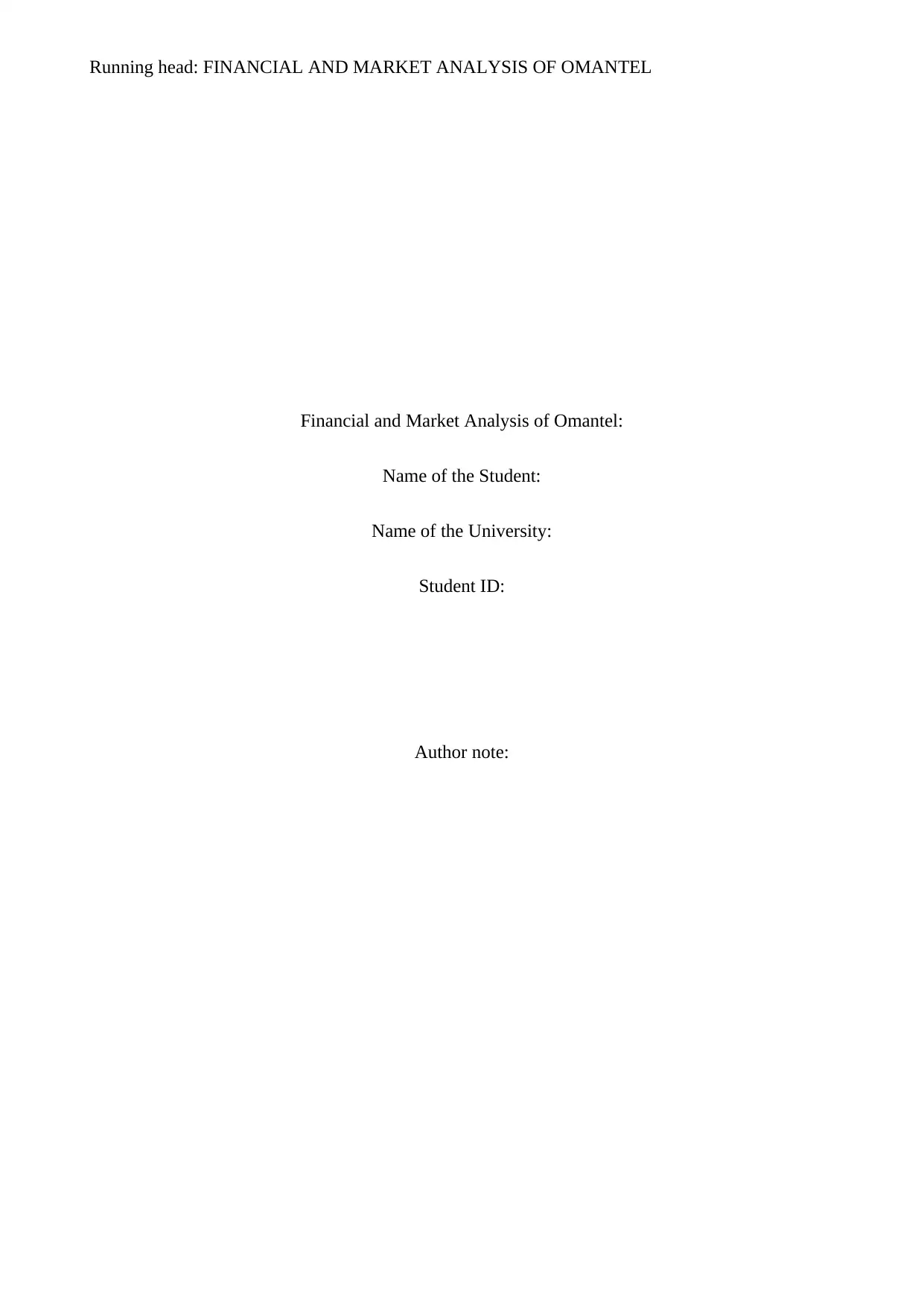
Running head: FINANCIAL AND MARKET ANALYSIS OF OMANTEL
Financial and Market Analysis of Omantel:
Name of the Student:
Name of the University:
Student ID:
Author note:
Financial and Market Analysis of Omantel:
Name of the Student:
Name of the University:
Student ID:
Author note:
Secure Best Marks with AI Grader
Need help grading? Try our AI Grader for instant feedback on your assignments.
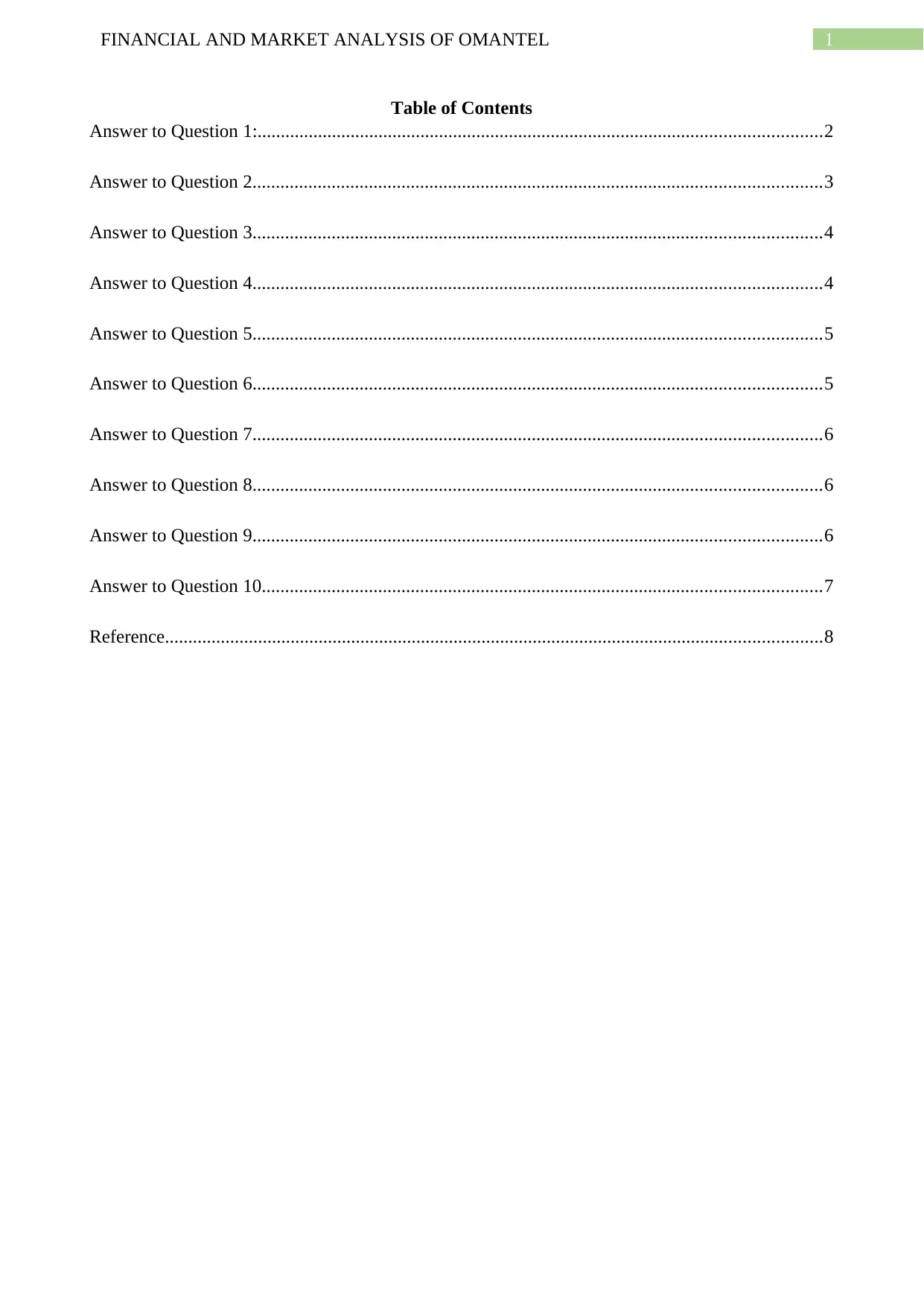
1FINANCIAL AND MARKET ANALYSIS OF OMANTEL
Table of Contents
Answer to Question 1:.........................................................................................................................2
Answer to Question 2..........................................................................................................................3
Answer to Question 3..........................................................................................................................4
Answer to Question 4..........................................................................................................................4
Answer to Question 5..........................................................................................................................5
Answer to Question 6..........................................................................................................................5
Answer to Question 7..........................................................................................................................6
Answer to Question 8..........................................................................................................................6
Answer to Question 9..........................................................................................................................6
Answer to Question 10........................................................................................................................7
Reference.............................................................................................................................................8
Table of Contents
Answer to Question 1:.........................................................................................................................2
Answer to Question 2..........................................................................................................................3
Answer to Question 3..........................................................................................................................4
Answer to Question 4..........................................................................................................................4
Answer to Question 5..........................................................................................................................5
Answer to Question 6..........................................................................................................................5
Answer to Question 7..........................................................................................................................6
Answer to Question 8..........................................................................................................................6
Answer to Question 9..........................................................................................................................6
Answer to Question 10........................................................................................................................7
Reference.............................................................................................................................................8
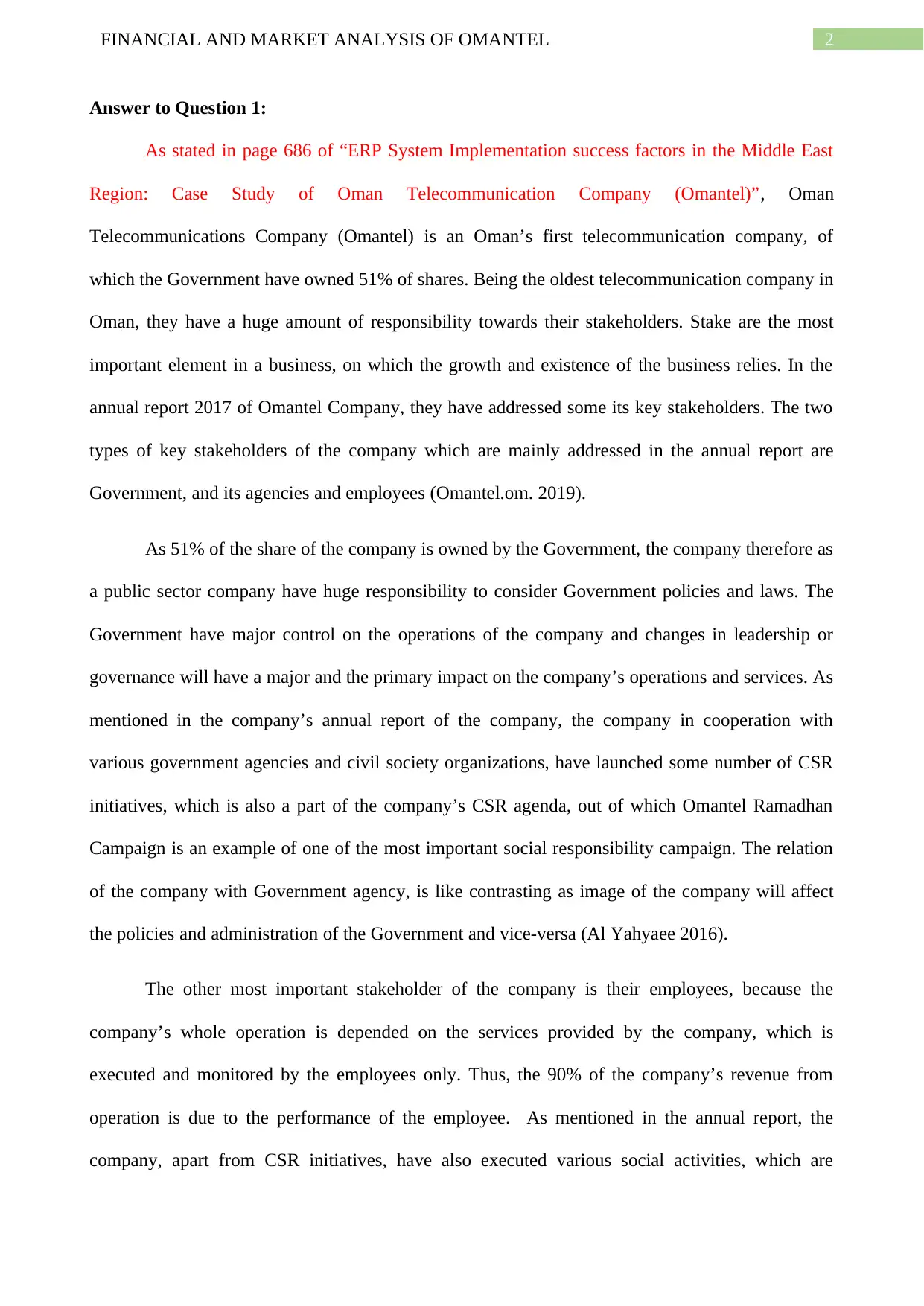
2FINANCIAL AND MARKET ANALYSIS OF OMANTEL
Answer to Question 1:
As stated in page 686 of “ERP System Implementation success factors in the Middle East
Region: Case Study of Oman Telecommunication Company (Omantel)”, Oman
Telecommunications Company (Omantel) is an Oman’s first telecommunication company, of
which the Government have owned 51% of shares. Being the oldest telecommunication company in
Oman, they have a huge amount of responsibility towards their stakeholders. Stake are the most
important element in a business, on which the growth and existence of the business relies. In the
annual report 2017 of Omantel Company, they have addressed some its key stakeholders. The two
types of key stakeholders of the company which are mainly addressed in the annual report are
Government, and its agencies and employees (Omantel.om. 2019).
As 51% of the share of the company is owned by the Government, the company therefore as
a public sector company have huge responsibility to consider Government policies and laws. The
Government have major control on the operations of the company and changes in leadership or
governance will have a major and the primary impact on the company’s operations and services. As
mentioned in the company’s annual report of the company, the company in cooperation with
various government agencies and civil society organizations, have launched some number of CSR
initiatives, which is also a part of the company’s CSR agenda, out of which Omantel Ramadhan
Campaign is an example of one of the most important social responsibility campaign. The relation
of the company with Government agency, is like contrasting as image of the company will affect
the policies and administration of the Government and vice-versa (Al Yahyaee 2016).
The other most important stakeholder of the company is their employees, because the
company’s whole operation is depended on the services provided by the company, which is
executed and monitored by the employees only. Thus, the 90% of the company’s revenue from
operation is due to the performance of the employee. As mentioned in the annual report, the
company, apart from CSR initiatives, have also executed various social activities, which are
Answer to Question 1:
As stated in page 686 of “ERP System Implementation success factors in the Middle East
Region: Case Study of Oman Telecommunication Company (Omantel)”, Oman
Telecommunications Company (Omantel) is an Oman’s first telecommunication company, of
which the Government have owned 51% of shares. Being the oldest telecommunication company in
Oman, they have a huge amount of responsibility towards their stakeholders. Stake are the most
important element in a business, on which the growth and existence of the business relies. In the
annual report 2017 of Omantel Company, they have addressed some its key stakeholders. The two
types of key stakeholders of the company which are mainly addressed in the annual report are
Government, and its agencies and employees (Omantel.om. 2019).
As 51% of the share of the company is owned by the Government, the company therefore as
a public sector company have huge responsibility to consider Government policies and laws. The
Government have major control on the operations of the company and changes in leadership or
governance will have a major and the primary impact on the company’s operations and services. As
mentioned in the company’s annual report of the company, the company in cooperation with
various government agencies and civil society organizations, have launched some number of CSR
initiatives, which is also a part of the company’s CSR agenda, out of which Omantel Ramadhan
Campaign is an example of one of the most important social responsibility campaign. The relation
of the company with Government agency, is like contrasting as image of the company will affect
the policies and administration of the Government and vice-versa (Al Yahyaee 2016).
The other most important stakeholder of the company is their employees, because the
company’s whole operation is depended on the services provided by the company, which is
executed and monitored by the employees only. Thus, the 90% of the company’s revenue from
operation is due to the performance of the employee. As mentioned in the annual report, the
company, apart from CSR initiatives, have also executed various social activities, which are
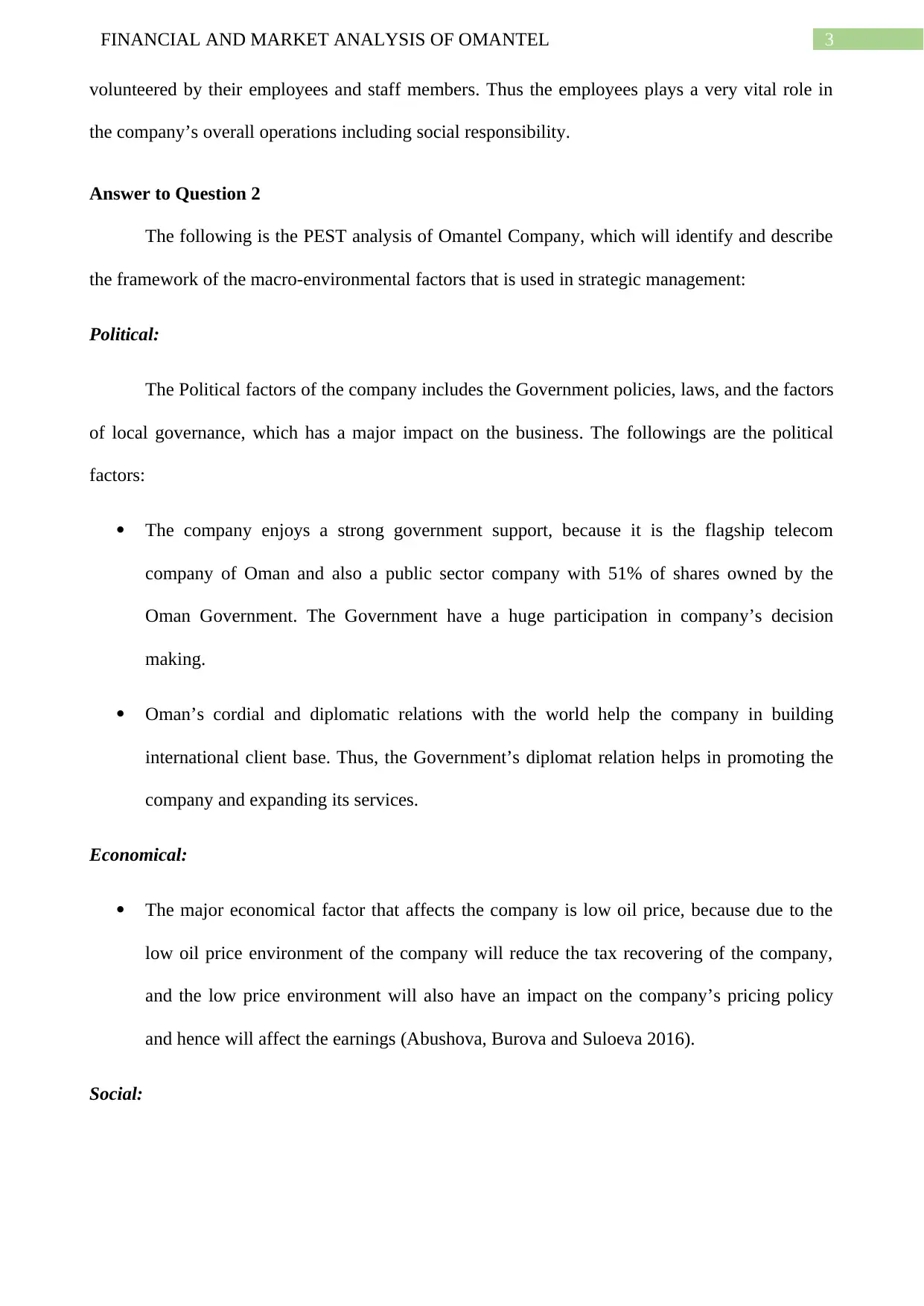
3FINANCIAL AND MARKET ANALYSIS OF OMANTEL
volunteered by their employees and staff members. Thus the employees plays a very vital role in
the company’s overall operations including social responsibility.
Answer to Question 2
The following is the PEST analysis of Omantel Company, which will identify and describe
the framework of the macro-environmental factors that is used in strategic management:
Political:
The Political factors of the company includes the Government policies, laws, and the factors
of local governance, which has a major impact on the business. The followings are the political
factors:
The company enjoys a strong government support, because it is the flagship telecom
company of Oman and also a public sector company with 51% of shares owned by the
Oman Government. The Government have a huge participation in company’s decision
making.
Oman’s cordial and diplomatic relations with the world help the company in building
international client base. Thus, the Government’s diplomat relation helps in promoting the
company and expanding its services.
Economical:
The major economical factor that affects the company is low oil price, because due to the
low oil price environment of the company will reduce the tax recovering of the company,
and the low price environment will also have an impact on the company’s pricing policy
and hence will affect the earnings (Abushova, Burova and Suloeva 2016).
Social:
volunteered by their employees and staff members. Thus the employees plays a very vital role in
the company’s overall operations including social responsibility.
Answer to Question 2
The following is the PEST analysis of Omantel Company, which will identify and describe
the framework of the macro-environmental factors that is used in strategic management:
Political:
The Political factors of the company includes the Government policies, laws, and the factors
of local governance, which has a major impact on the business. The followings are the political
factors:
The company enjoys a strong government support, because it is the flagship telecom
company of Oman and also a public sector company with 51% of shares owned by the
Oman Government. The Government have a huge participation in company’s decision
making.
Oman’s cordial and diplomatic relations with the world help the company in building
international client base. Thus, the Government’s diplomat relation helps in promoting the
company and expanding its services.
Economical:
The major economical factor that affects the company is low oil price, because due to the
low oil price environment of the company will reduce the tax recovering of the company,
and the low price environment will also have an impact on the company’s pricing policy
and hence will affect the earnings (Abushova, Burova and Suloeva 2016).
Social:
Secure Best Marks with AI Grader
Need help grading? Try our AI Grader for instant feedback on your assignments.
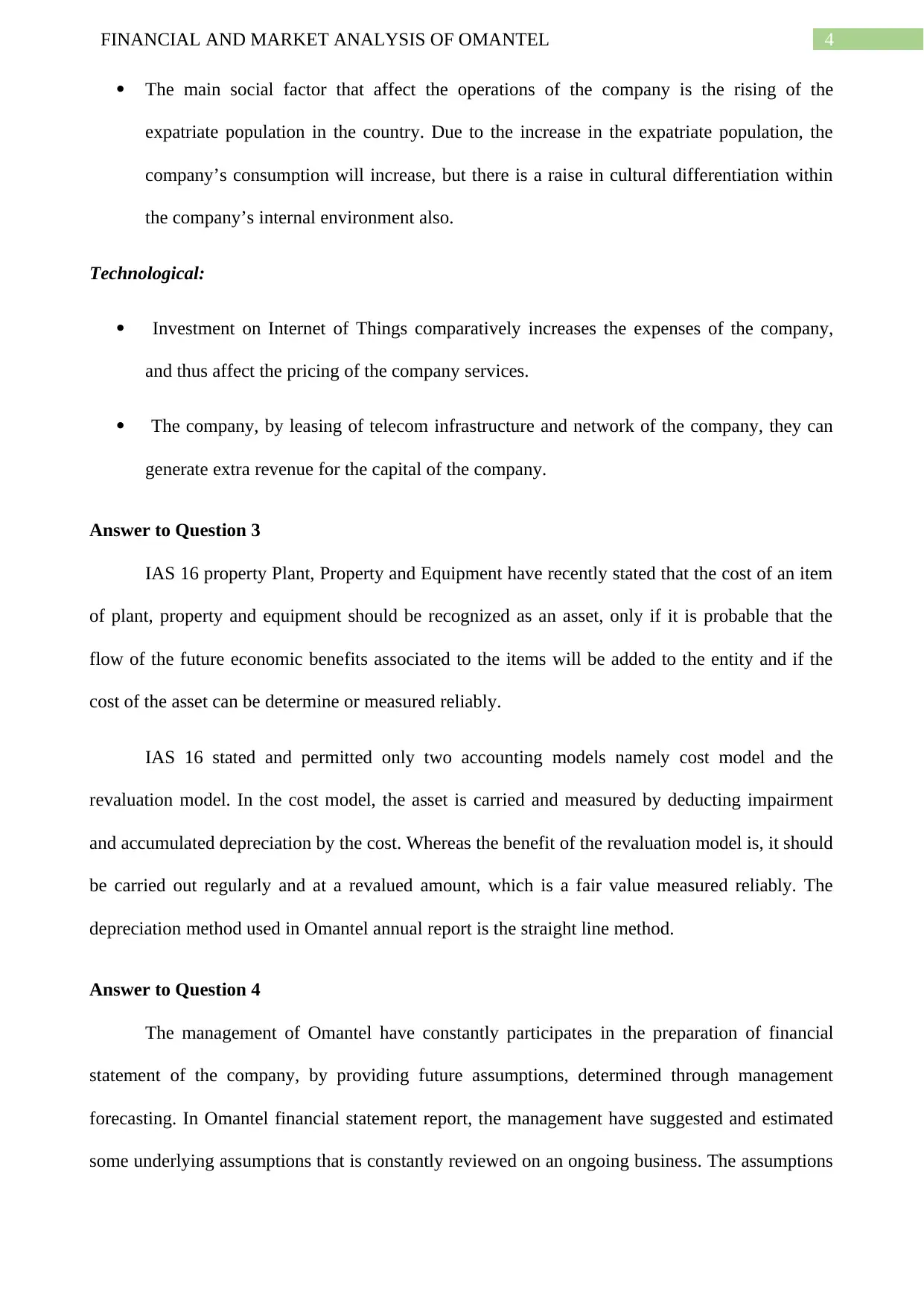
4FINANCIAL AND MARKET ANALYSIS OF OMANTEL
The main social factor that affect the operations of the company is the rising of the
expatriate population in the country. Due to the increase in the expatriate population, the
company’s consumption will increase, but there is a raise in cultural differentiation within
the company’s internal environment also.
Technological:
Investment on Internet of Things comparatively increases the expenses of the company,
and thus affect the pricing of the company services.
The company, by leasing of telecom infrastructure and network of the company, they can
generate extra revenue for the capital of the company.
Answer to Question 3
IAS 16 property Plant, Property and Equipment have recently stated that the cost of an item
of plant, property and equipment should be recognized as an asset, only if it is probable that the
flow of the future economic benefits associated to the items will be added to the entity and if the
cost of the asset can be determine or measured reliably.
IAS 16 stated and permitted only two accounting models namely cost model and the
revaluation model. In the cost model, the asset is carried and measured by deducting impairment
and accumulated depreciation by the cost. Whereas the benefit of the revaluation model is, it should
be carried out regularly and at a revalued amount, which is a fair value measured reliably. The
depreciation method used in Omantel annual report is the straight line method.
Answer to Question 4
The management of Omantel have constantly participates in the preparation of financial
statement of the company, by providing future assumptions, determined through management
forecasting. In Omantel financial statement report, the management have suggested and estimated
some underlying assumptions that is constantly reviewed on an ongoing business. The assumptions
The main social factor that affect the operations of the company is the rising of the
expatriate population in the country. Due to the increase in the expatriate population, the
company’s consumption will increase, but there is a raise in cultural differentiation within
the company’s internal environment also.
Technological:
Investment on Internet of Things comparatively increases the expenses of the company,
and thus affect the pricing of the company services.
The company, by leasing of telecom infrastructure and network of the company, they can
generate extra revenue for the capital of the company.
Answer to Question 3
IAS 16 property Plant, Property and Equipment have recently stated that the cost of an item
of plant, property and equipment should be recognized as an asset, only if it is probable that the
flow of the future economic benefits associated to the items will be added to the entity and if the
cost of the asset can be determine or measured reliably.
IAS 16 stated and permitted only two accounting models namely cost model and the
revaluation model. In the cost model, the asset is carried and measured by deducting impairment
and accumulated depreciation by the cost. Whereas the benefit of the revaluation model is, it should
be carried out regularly and at a revalued amount, which is a fair value measured reliably. The
depreciation method used in Omantel annual report is the straight line method.
Answer to Question 4
The management of Omantel have constantly participates in the preparation of financial
statement of the company, by providing future assumptions, determined through management
forecasting. In Omantel financial statement report, the management have suggested and estimated
some underlying assumptions that is constantly reviewed on an ongoing business. The assumptions
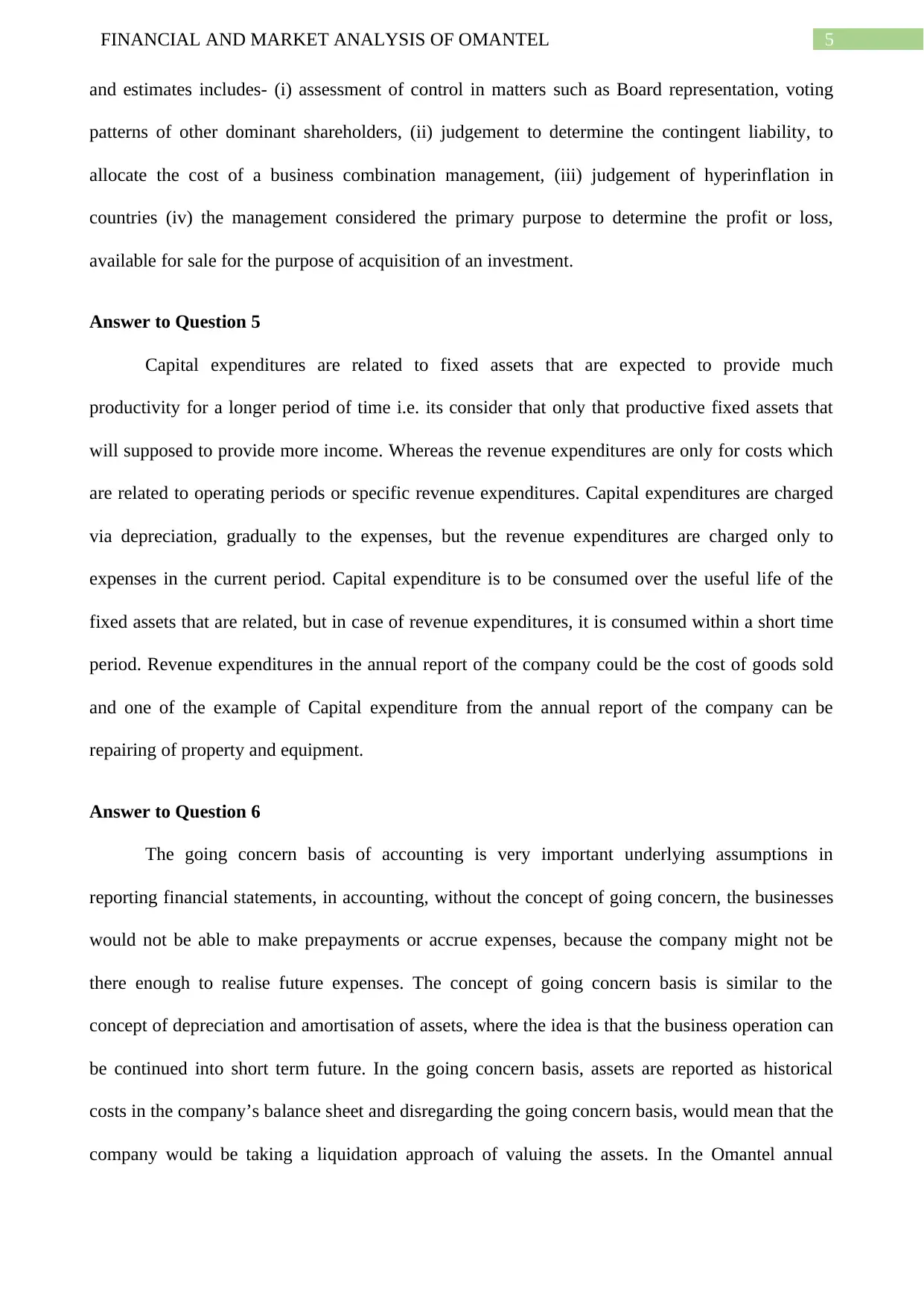
5FINANCIAL AND MARKET ANALYSIS OF OMANTEL
and estimates includes- (i) assessment of control in matters such as Board representation, voting
patterns of other dominant shareholders, (ii) judgement to determine the contingent liability, to
allocate the cost of a business combination management, (iii) judgement of hyperinflation in
countries (iv) the management considered the primary purpose to determine the profit or loss,
available for sale for the purpose of acquisition of an investment.
Answer to Question 5
Capital expenditures are related to fixed assets that are expected to provide much
productivity for a longer period of time i.e. its consider that only that productive fixed assets that
will supposed to provide more income. Whereas the revenue expenditures are only for costs which
are related to operating periods or specific revenue expenditures. Capital expenditures are charged
via depreciation, gradually to the expenses, but the revenue expenditures are charged only to
expenses in the current period. Capital expenditure is to be consumed over the useful life of the
fixed assets that are related, but in case of revenue expenditures, it is consumed within a short time
period. Revenue expenditures in the annual report of the company could be the cost of goods sold
and one of the example of Capital expenditure from the annual report of the company can be
repairing of property and equipment.
Answer to Question 6
The going concern basis of accounting is very important underlying assumptions in
reporting financial statements, in accounting, without the concept of going concern, the businesses
would not be able to make prepayments or accrue expenses, because the company might not be
there enough to realise future expenses. The concept of going concern basis is similar to the
concept of depreciation and amortisation of assets, where the idea is that the business operation can
be continued into short term future. In the going concern basis, assets are reported as historical
costs in the company’s balance sheet and disregarding the going concern basis, would mean that the
company would be taking a liquidation approach of valuing the assets. In the Omantel annual
and estimates includes- (i) assessment of control in matters such as Board representation, voting
patterns of other dominant shareholders, (ii) judgement to determine the contingent liability, to
allocate the cost of a business combination management, (iii) judgement of hyperinflation in
countries (iv) the management considered the primary purpose to determine the profit or loss,
available for sale for the purpose of acquisition of an investment.
Answer to Question 5
Capital expenditures are related to fixed assets that are expected to provide much
productivity for a longer period of time i.e. its consider that only that productive fixed assets that
will supposed to provide more income. Whereas the revenue expenditures are only for costs which
are related to operating periods or specific revenue expenditures. Capital expenditures are charged
via depreciation, gradually to the expenses, but the revenue expenditures are charged only to
expenses in the current period. Capital expenditure is to be consumed over the useful life of the
fixed assets that are related, but in case of revenue expenditures, it is consumed within a short time
period. Revenue expenditures in the annual report of the company could be the cost of goods sold
and one of the example of Capital expenditure from the annual report of the company can be
repairing of property and equipment.
Answer to Question 6
The going concern basis of accounting is very important underlying assumptions in
reporting financial statements, in accounting, without the concept of going concern, the businesses
would not be able to make prepayments or accrue expenses, because the company might not be
there enough to realise future expenses. The concept of going concern basis is similar to the
concept of depreciation and amortisation of assets, where the idea is that the business operation can
be continued into short term future. In the going concern basis, assets are reported as historical
costs in the company’s balance sheet and disregarding the going concern basis, would mean that the
company would be taking a liquidation approach of valuing the assets. In the Omantel annual
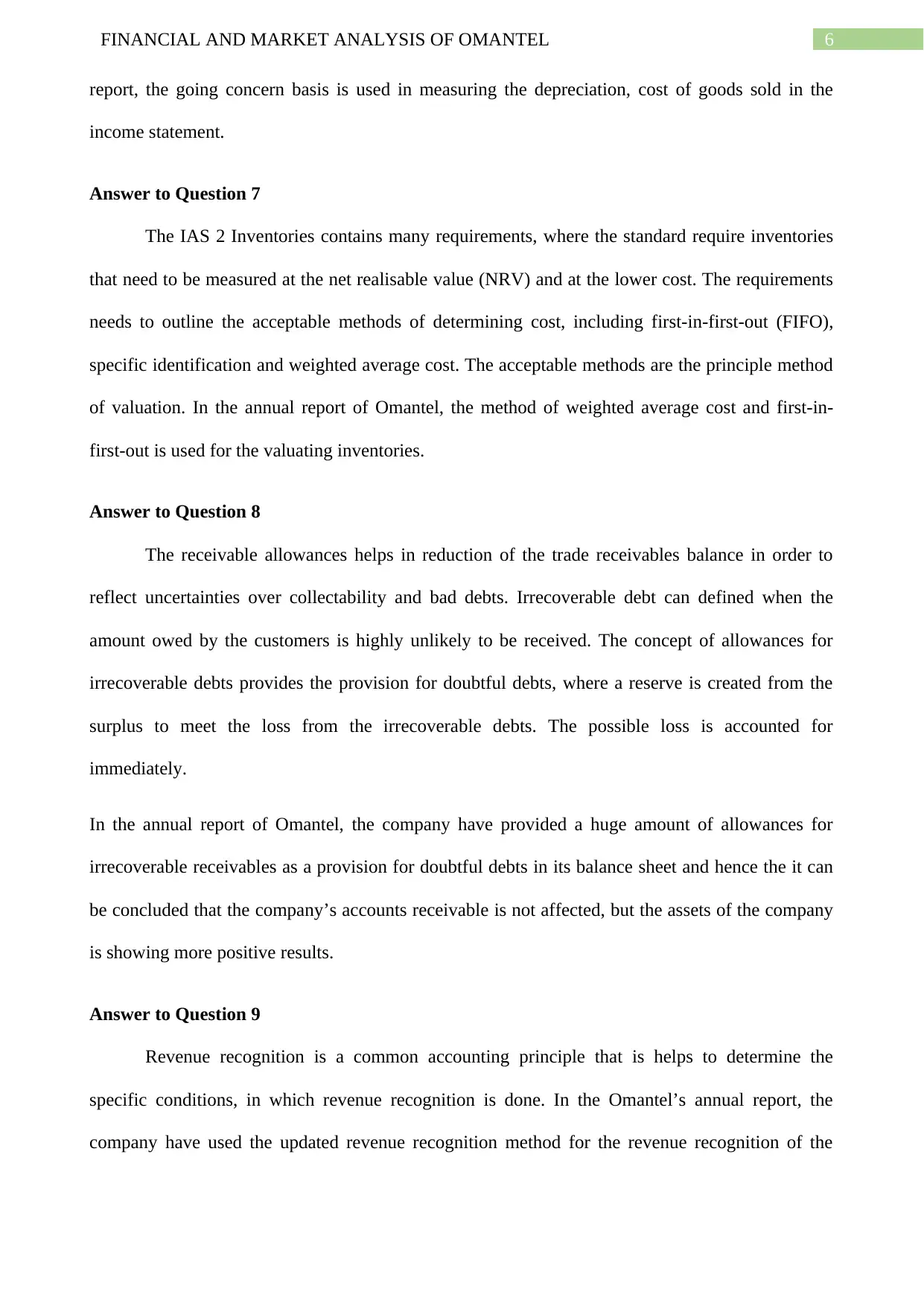
6FINANCIAL AND MARKET ANALYSIS OF OMANTEL
report, the going concern basis is used in measuring the depreciation, cost of goods sold in the
income statement.
Answer to Question 7
The IAS 2 Inventories contains many requirements, where the standard require inventories
that need to be measured at the net realisable value (NRV) and at the lower cost. The requirements
needs to outline the acceptable methods of determining cost, including first-in-first-out (FIFO),
specific identification and weighted average cost. The acceptable methods are the principle method
of valuation. In the annual report of Omantel, the method of weighted average cost and first-in-
first-out is used for the valuating inventories.
Answer to Question 8
The receivable allowances helps in reduction of the trade receivables balance in order to
reflect uncertainties over collectability and bad debts. Irrecoverable debt can defined when the
amount owed by the customers is highly unlikely to be received. The concept of allowances for
irrecoverable debts provides the provision for doubtful debts, where a reserve is created from the
surplus to meet the loss from the irrecoverable debts. The possible loss is accounted for
immediately.
In the annual report of Omantel, the company have provided a huge amount of allowances for
irrecoverable receivables as a provision for doubtful debts in its balance sheet and hence the it can
be concluded that the company’s accounts receivable is not affected, but the assets of the company
is showing more positive results.
Answer to Question 9
Revenue recognition is a common accounting principle that is helps to determine the
specific conditions, in which revenue recognition is done. In the Omantel’s annual report, the
company have used the updated revenue recognition method for the revenue recognition of the
report, the going concern basis is used in measuring the depreciation, cost of goods sold in the
income statement.
Answer to Question 7
The IAS 2 Inventories contains many requirements, where the standard require inventories
that need to be measured at the net realisable value (NRV) and at the lower cost. The requirements
needs to outline the acceptable methods of determining cost, including first-in-first-out (FIFO),
specific identification and weighted average cost. The acceptable methods are the principle method
of valuation. In the annual report of Omantel, the method of weighted average cost and first-in-
first-out is used for the valuating inventories.
Answer to Question 8
The receivable allowances helps in reduction of the trade receivables balance in order to
reflect uncertainties over collectability and bad debts. Irrecoverable debt can defined when the
amount owed by the customers is highly unlikely to be received. The concept of allowances for
irrecoverable debts provides the provision for doubtful debts, where a reserve is created from the
surplus to meet the loss from the irrecoverable debts. The possible loss is accounted for
immediately.
In the annual report of Omantel, the company have provided a huge amount of allowances for
irrecoverable receivables as a provision for doubtful debts in its balance sheet and hence the it can
be concluded that the company’s accounts receivable is not affected, but the assets of the company
is showing more positive results.
Answer to Question 9
Revenue recognition is a common accounting principle that is helps to determine the
specific conditions, in which revenue recognition is done. In the Omantel’s annual report, the
company have used the updated revenue recognition method for the revenue recognition of the
Paraphrase This Document
Need a fresh take? Get an instant paraphrase of this document with our AI Paraphraser
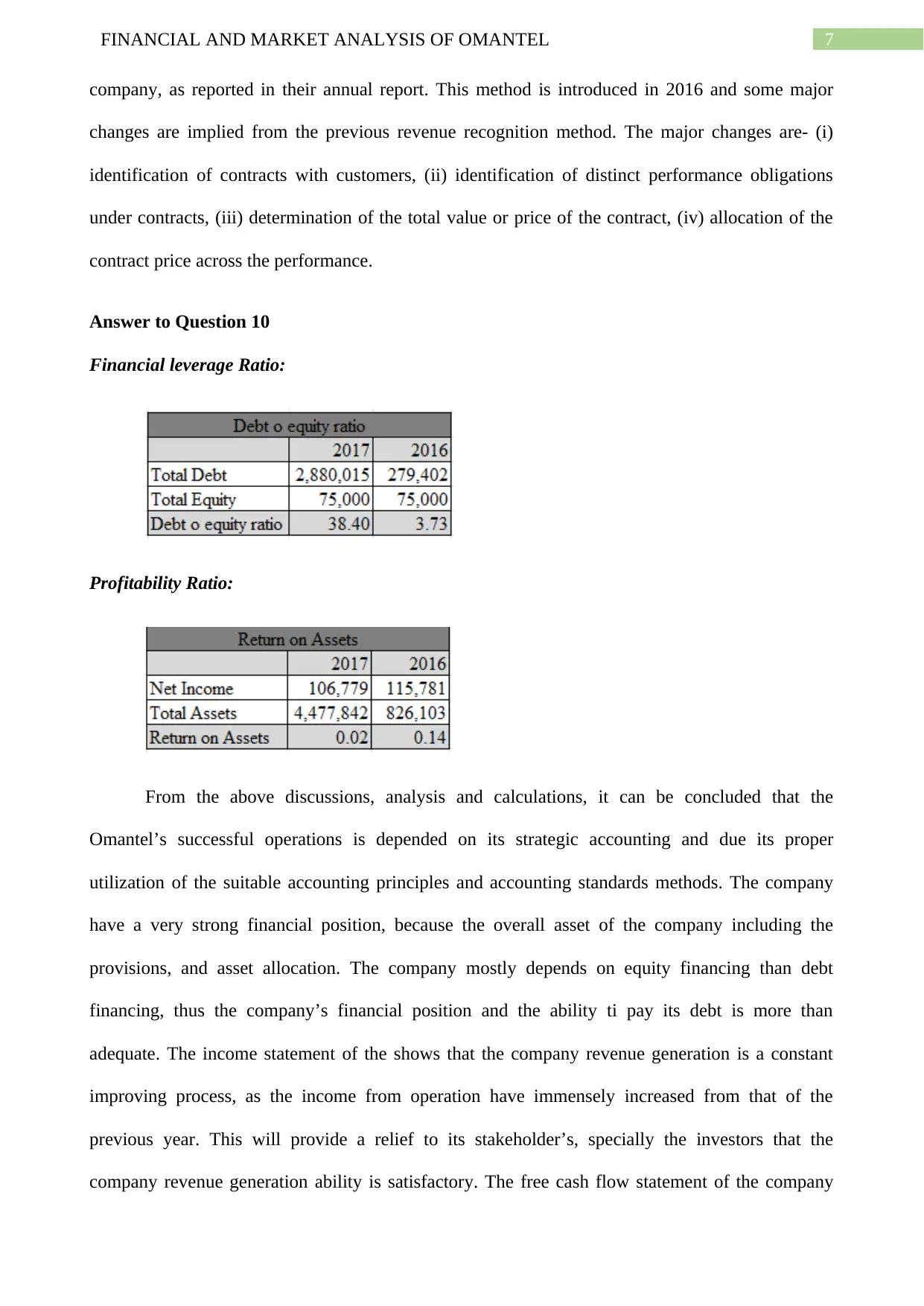
7FINANCIAL AND MARKET ANALYSIS OF OMANTEL
company, as reported in their annual report. This method is introduced in 2016 and some major
changes are implied from the previous revenue recognition method. The major changes are- (i)
identification of contracts with customers, (ii) identification of distinct performance obligations
under contracts, (iii) determination of the total value or price of the contract, (iv) allocation of the
contract price across the performance.
Answer to Question 10
Financial leverage Ratio:
Profitability Ratio:
From the above discussions, analysis and calculations, it can be concluded that the
Omantel’s successful operations is depended on its strategic accounting and due its proper
utilization of the suitable accounting principles and accounting standards methods. The company
have a very strong financial position, because the overall asset of the company including the
provisions, and asset allocation. The company mostly depends on equity financing than debt
financing, thus the company’s financial position and the ability ti pay its debt is more than
adequate. The income statement of the shows that the company revenue generation is a constant
improving process, as the income from operation have immensely increased from that of the
previous year. This will provide a relief to its stakeholder’s, specially the investors that the
company revenue generation ability is satisfactory. The free cash flow statement of the company
company, as reported in their annual report. This method is introduced in 2016 and some major
changes are implied from the previous revenue recognition method. The major changes are- (i)
identification of contracts with customers, (ii) identification of distinct performance obligations
under contracts, (iii) determination of the total value or price of the contract, (iv) allocation of the
contract price across the performance.
Answer to Question 10
Financial leverage Ratio:
Profitability Ratio:
From the above discussions, analysis and calculations, it can be concluded that the
Omantel’s successful operations is depended on its strategic accounting and due its proper
utilization of the suitable accounting principles and accounting standards methods. The company
have a very strong financial position, because the overall asset of the company including the
provisions, and asset allocation. The company mostly depends on equity financing than debt
financing, thus the company’s financial position and the ability ti pay its debt is more than
adequate. The income statement of the shows that the company revenue generation is a constant
improving process, as the income from operation have immensely increased from that of the
previous year. This will provide a relief to its stakeholder’s, specially the investors that the
company revenue generation ability is satisfactory. The free cash flow statement of the company
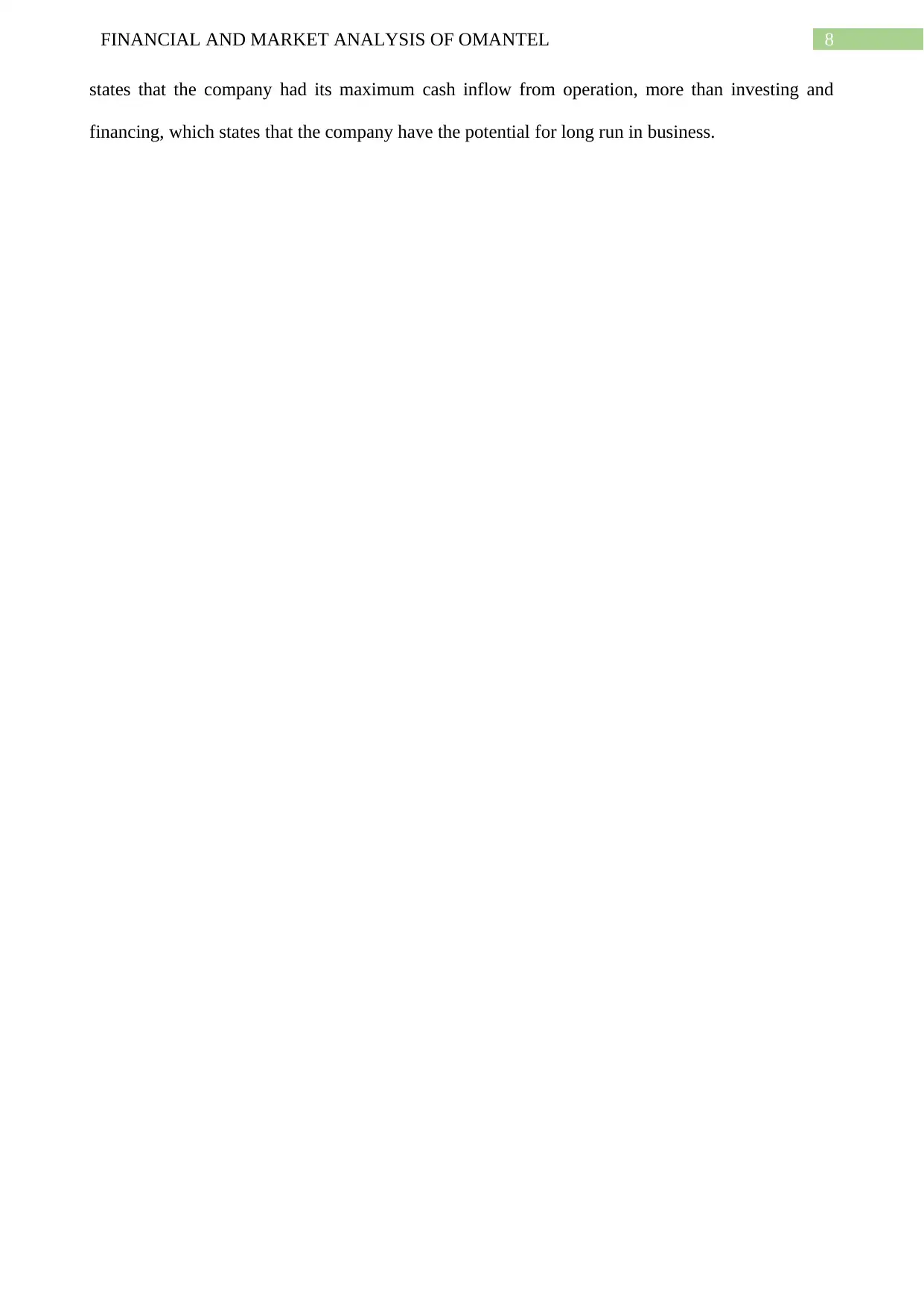
8FINANCIAL AND MARKET ANALYSIS OF OMANTEL
states that the company had its maximum cash inflow from operation, more than investing and
financing, which states that the company have the potential for long run in business.
states that the company had its maximum cash inflow from operation, more than investing and
financing, which states that the company have the potential for long run in business.
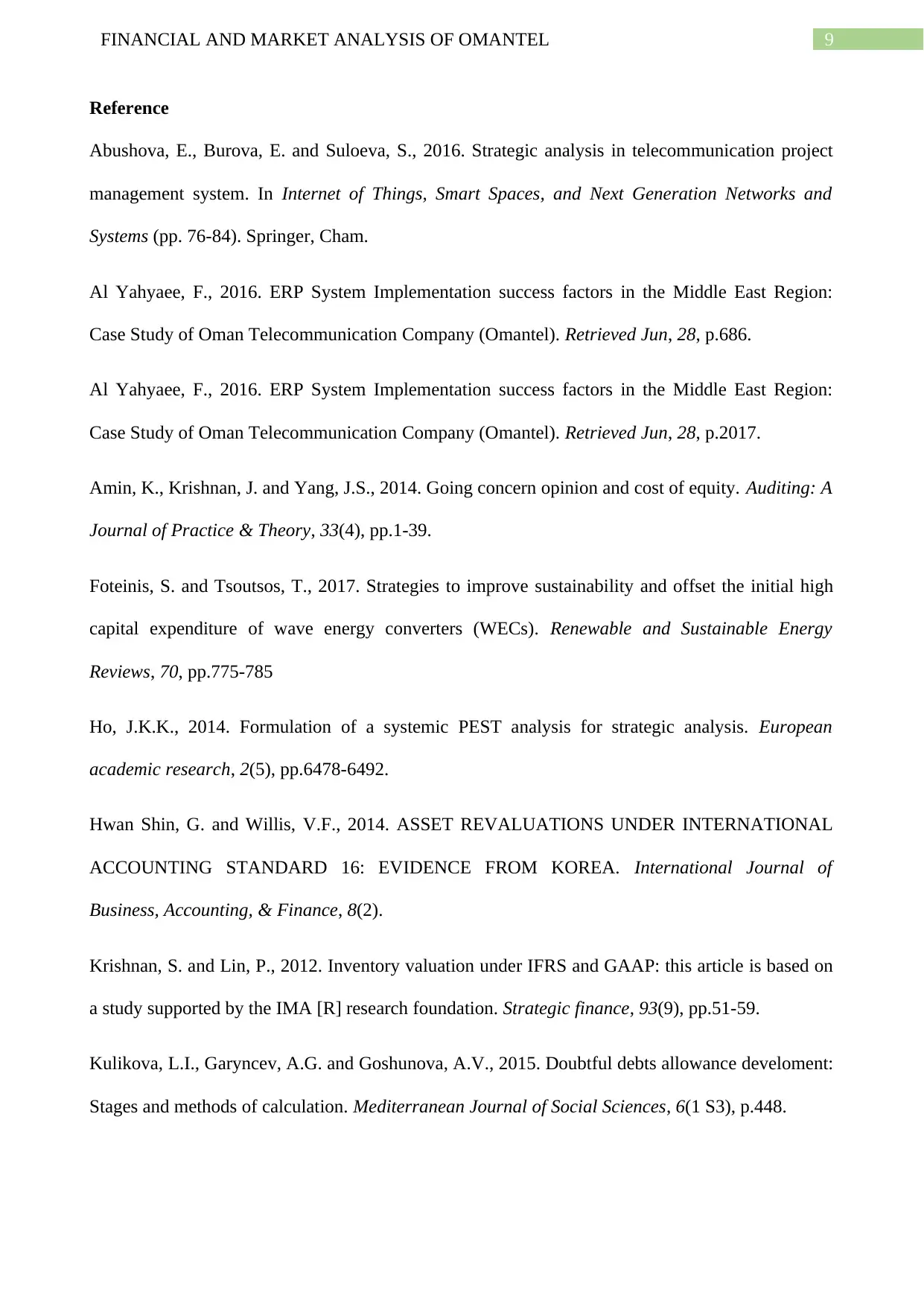
9FINANCIAL AND MARKET ANALYSIS OF OMANTEL
Reference
Abushova, E., Burova, E. and Suloeva, S., 2016. Strategic analysis in telecommunication project
management system. In Internet of Things, Smart Spaces, and Next Generation Networks and
Systems (pp. 76-84). Springer, Cham.
Al Yahyaee, F., 2016. ERP System Implementation success factors in the Middle East Region:
Case Study of Oman Telecommunication Company (Omantel). Retrieved Jun, 28, p.686.
Al Yahyaee, F., 2016. ERP System Implementation success factors in the Middle East Region:
Case Study of Oman Telecommunication Company (Omantel). Retrieved Jun, 28, p.2017.
Amin, K., Krishnan, J. and Yang, J.S., 2014. Going concern opinion and cost of equity. Auditing: A
Journal of Practice & Theory, 33(4), pp.1-39.
Foteinis, S. and Tsoutsos, T., 2017. Strategies to improve sustainability and offset the initial high
capital expenditure of wave energy converters (WECs). Renewable and Sustainable Energy
Reviews, 70, pp.775-785
Ho, J.K.K., 2014. Formulation of a systemic PEST analysis for strategic analysis. European
academic research, 2(5), pp.6478-6492.
Hwan Shin, G. and Willis, V.F., 2014. ASSET REVALUATIONS UNDER INTERNATIONAL
ACCOUNTING STANDARD 16: EVIDENCE FROM KOREA. International Journal of
Business, Accounting, & Finance, 8(2).
Krishnan, S. and Lin, P., 2012. Inventory valuation under IFRS and GAAP: this article is based on
a study supported by the IMA [R] research foundation. Strategic finance, 93(9), pp.51-59.
Kulikova, L.I., Garyncev, A.G. and Goshunova, A.V., 2015. Doubtful debts allowance develoment:
Stages and methods of calculation. Mediterranean Journal of Social Sciences, 6(1 S3), p.448.
Reference
Abushova, E., Burova, E. and Suloeva, S., 2016. Strategic analysis in telecommunication project
management system. In Internet of Things, Smart Spaces, and Next Generation Networks and
Systems (pp. 76-84). Springer, Cham.
Al Yahyaee, F., 2016. ERP System Implementation success factors in the Middle East Region:
Case Study of Oman Telecommunication Company (Omantel). Retrieved Jun, 28, p.686.
Al Yahyaee, F., 2016. ERP System Implementation success factors in the Middle East Region:
Case Study of Oman Telecommunication Company (Omantel). Retrieved Jun, 28, p.2017.
Amin, K., Krishnan, J. and Yang, J.S., 2014. Going concern opinion and cost of equity. Auditing: A
Journal of Practice & Theory, 33(4), pp.1-39.
Foteinis, S. and Tsoutsos, T., 2017. Strategies to improve sustainability and offset the initial high
capital expenditure of wave energy converters (WECs). Renewable and Sustainable Energy
Reviews, 70, pp.775-785
Ho, J.K.K., 2014. Formulation of a systemic PEST analysis for strategic analysis. European
academic research, 2(5), pp.6478-6492.
Hwan Shin, G. and Willis, V.F., 2014. ASSET REVALUATIONS UNDER INTERNATIONAL
ACCOUNTING STANDARD 16: EVIDENCE FROM KOREA. International Journal of
Business, Accounting, & Finance, 8(2).
Krishnan, S. and Lin, P., 2012. Inventory valuation under IFRS and GAAP: this article is based on
a study supported by the IMA [R] research foundation. Strategic finance, 93(9), pp.51-59.
Kulikova, L.I., Garyncev, A.G. and Goshunova, A.V., 2015. Doubtful debts allowance develoment:
Stages and methods of calculation. Mediterranean Journal of Social Sciences, 6(1 S3), p.448.
Secure Best Marks with AI Grader
Need help grading? Try our AI Grader for instant feedback on your assignments.
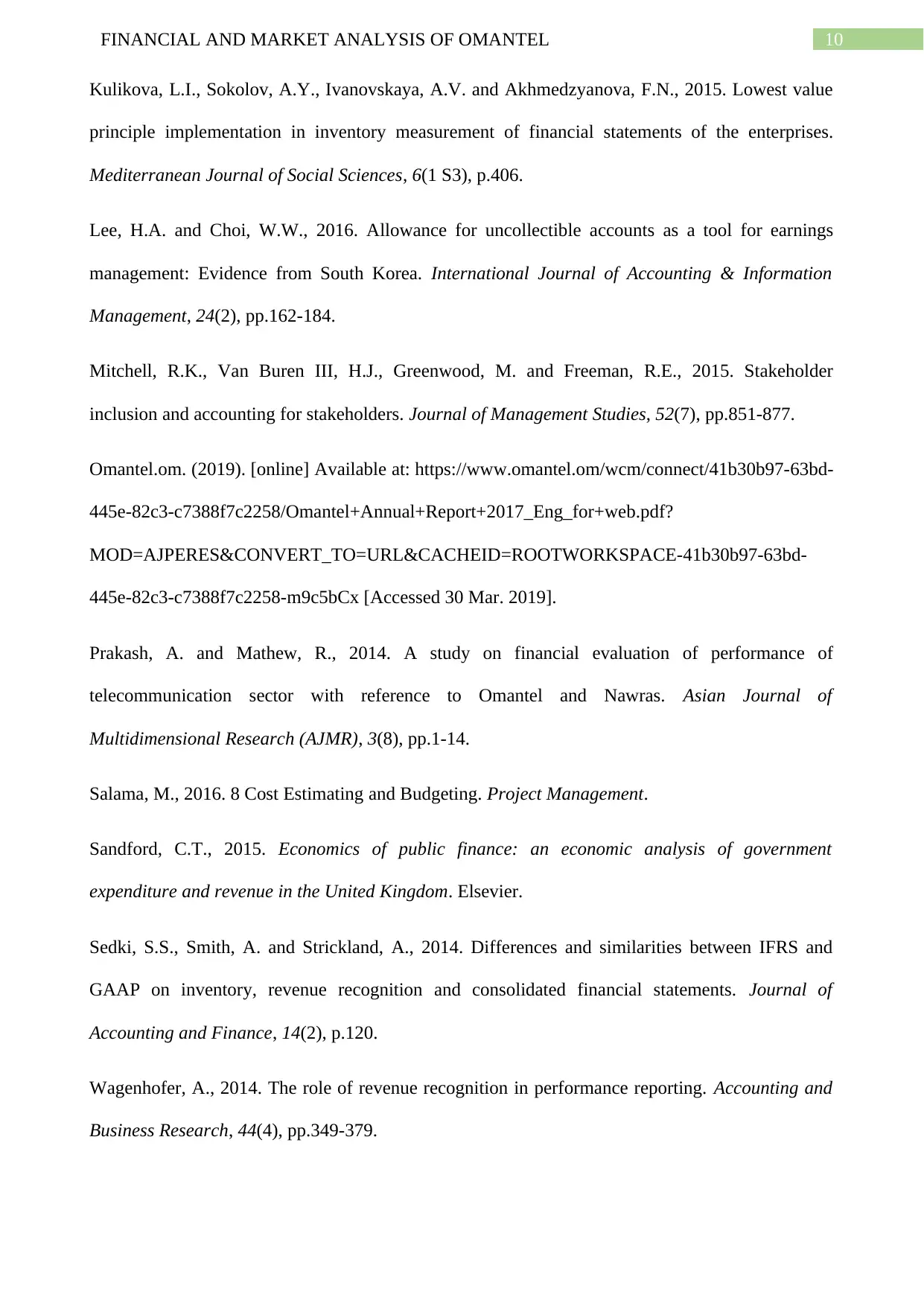
10FINANCIAL AND MARKET ANALYSIS OF OMANTEL
Kulikova, L.I., Sokolov, A.Y., Ivanovskaya, A.V. and Akhmedzyanova, F.N., 2015. Lowest value
principle implementation in inventory measurement of financial statements of the enterprises.
Mediterranean Journal of Social Sciences, 6(1 S3), p.406.
Lee, H.A. and Choi, W.W., 2016. Allowance for uncollectible accounts as a tool for earnings
management: Evidence from South Korea. International Journal of Accounting & Information
Management, 24(2), pp.162-184.
Mitchell, R.K., Van Buren III, H.J., Greenwood, M. and Freeman, R.E., 2015. Stakeholder
inclusion and accounting for stakeholders. Journal of Management Studies, 52(7), pp.851-877.
Omantel.om. (2019). [online] Available at: https://www.omantel.om/wcm/connect/41b30b97-63bd-
445e-82c3-c7388f7c2258/Omantel+Annual+Report+2017_Eng_for+web.pdf?
MOD=AJPERES&CONVERT_TO=URL&CACHEID=ROOTWORKSPACE-41b30b97-63bd-
445e-82c3-c7388f7c2258-m9c5bCx [Accessed 30 Mar. 2019].
Prakash, A. and Mathew, R., 2014. A study on financial evaluation of performance of
telecommunication sector with reference to Omantel and Nawras. Asian Journal of
Multidimensional Research (AJMR), 3(8), pp.1-14.
Salama, M., 2016. 8 Cost Estimating and Budgeting. Project Management.
Sandford, C.T., 2015. Economics of public finance: an economic analysis of government
expenditure and revenue in the United Kingdom. Elsevier.
Sedki, S.S., Smith, A. and Strickland, A., 2014. Differences and similarities between IFRS and
GAAP on inventory, revenue recognition and consolidated financial statements. Journal of
Accounting and Finance, 14(2), p.120.
Wagenhofer, A., 2014. The role of revenue recognition in performance reporting. Accounting and
Business Research, 44(4), pp.349-379.
Kulikova, L.I., Sokolov, A.Y., Ivanovskaya, A.V. and Akhmedzyanova, F.N., 2015. Lowest value
principle implementation in inventory measurement of financial statements of the enterprises.
Mediterranean Journal of Social Sciences, 6(1 S3), p.406.
Lee, H.A. and Choi, W.W., 2016. Allowance for uncollectible accounts as a tool for earnings
management: Evidence from South Korea. International Journal of Accounting & Information
Management, 24(2), pp.162-184.
Mitchell, R.K., Van Buren III, H.J., Greenwood, M. and Freeman, R.E., 2015. Stakeholder
inclusion and accounting for stakeholders. Journal of Management Studies, 52(7), pp.851-877.
Omantel.om. (2019). [online] Available at: https://www.omantel.om/wcm/connect/41b30b97-63bd-
445e-82c3-c7388f7c2258/Omantel+Annual+Report+2017_Eng_for+web.pdf?
MOD=AJPERES&CONVERT_TO=URL&CACHEID=ROOTWORKSPACE-41b30b97-63bd-
445e-82c3-c7388f7c2258-m9c5bCx [Accessed 30 Mar. 2019].
Prakash, A. and Mathew, R., 2014. A study on financial evaluation of performance of
telecommunication sector with reference to Omantel and Nawras. Asian Journal of
Multidimensional Research (AJMR), 3(8), pp.1-14.
Salama, M., 2016. 8 Cost Estimating and Budgeting. Project Management.
Sandford, C.T., 2015. Economics of public finance: an economic analysis of government
expenditure and revenue in the United Kingdom. Elsevier.
Sedki, S.S., Smith, A. and Strickland, A., 2014. Differences and similarities between IFRS and
GAAP on inventory, revenue recognition and consolidated financial statements. Journal of
Accounting and Finance, 14(2), p.120.
Wagenhofer, A., 2014. The role of revenue recognition in performance reporting. Accounting and
Business Research, 44(4), pp.349-379.

11FINANCIAL AND MARKET ANALYSIS OF OMANTEL
Yeaton, K., 2015. A new world of revenue recognition: revenue from contracts with customers.
The CPA Journal, 85(7), p.50.
Yeaton, K., 2015. A new world of revenue recognition: revenue from contracts with customers.
The CPA Journal, 85(7), p.50.
1 out of 12
Related Documents
Your All-in-One AI-Powered Toolkit for Academic Success.
+13062052269
info@desklib.com
Available 24*7 on WhatsApp / Email
![[object Object]](/_next/static/media/star-bottom.7253800d.svg)
Unlock your academic potential
© 2024 | Zucol Services PVT LTD | All rights reserved.





